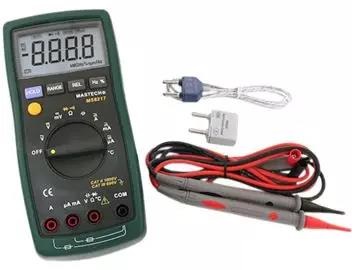Six parameters to read the digital multimeter
Digital Multimeters (DMMs) are among the most commonly used test tools for all electrical and electronic test instruments. Specifications and features of
each DMM may vary slightly. Understanding the terminology in the DMM specification can maximize our measurement efficiency.

1. Accuracy
This relates to the maximum allowable error that the DMM occurs under certain operating conditions. In most cases, accuracy is given in a percentage
indicating how close the displayed measured value is to the actual (standard) value of the measured signal. Efficiency needs to be compared to recognize
industry standards.
Calibration of certified applications, such as automotive, medical aviation, or specialized industrial equipment, may require higher precision. Read 100.0 V
on a digital multimeter with an accuracy of ±2% and a range of 98.0V to 102.0V. This may be an issue for some applications, but it is unacceptable for
sensitive electronic devices.
2. Resolution
This is the smallest increment of change that the DMM can detect and display. For example, if a digital multimeter (DMM) has a resolution of 1 mV in the
3 V range, a one mV change can be seen when reading 1 V. The user can see that the voltage change is as small as 0.001.
3. Measuring ranges
The measurement range and resolution of the DMM are related. Many DMMs offer an auto-ranging function to select the correct measurement range. This provides essential reading and the best measurement resolution.
If the measured value is above the set range, most DMMs will display OL (overload). Make the most accurate measurements at the lowest possible range
setting without overloading the multimeter.
4. Precision
Accuracy is the opportunity of a digital multimeter to provide the same measurement under the same measurement conditions repeatedly. In some cases,
if the measure is repeatable, the accuracy of the DMM is more essential to determine the error model and compensate for it.
5. Digital display
This refers to the resolution of the DMM. For example, a 31⁄2-digit DMM can display three full digits and one digit digits. The three figures display a
number between 0 and 9; the half figure (which is deemed to be the highest digit) shows 1 or remains blank. The 41⁄2-digit DMM can display four and a
half fingers, indicating a higher resolution.
6. Counter display
The counter display tells you what the DMM will display before changing to the next range. For instance, the DMM has 50,000 counts. This implies that its scope will change when it reaches 50,000 on display.
To illustrate, the 50,000 counter can read 49.999V on display, but when it tries to display 50V, it will only read 050.00V, or just 50.00V. If the multimeter
moves to the next range of numbers, it usually means that a resolution of one-digit will be canceled.
More information about other electronic component or PCBA, please feel free contact us.
















